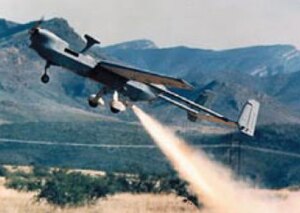IAI RQ-5 Hunter
| RQ-5 Hunter | |
|---|---|
 |
|
| A U.S. Army Hunter (RQ-5) UAV | |
| Role | Reconnaissance UAV |
| National origin | Israel |
| Manufacturer | TRW (acquired by Northrop Grumman in 2002) / IAI |
| Introduction | 1995 |
| Retired | 2015 |
| Status | Retired |
| Primary user | United States Army |
The IAI RQ-5 Hunter unmanned aerial vehicle (UAV) was originally intended to serve as the United States Army's Short Range UAV system for division and corps commanders. It took off and landed (using arresting gear) on runways. It used a gimbaled EO/IR sensor to relay its video in real time via a second airborne Hunter over a C-band line-of-sight data link. The RQ-5 is based on the Hunter UAV that was developed by Israel Aircraft Industries.
System acquisition and training started in 1994 but production was cancelled in 1996 due to concerns over program mismanagement. Seven low rate initial production (LRIP) systems of eight aircraft each were acquired, four of which remained in service: one for training and three for doctrine development, exercise, and contingency support. Hunter was to be replaced by the RQ-7 Shadow, but instead of being replaced, the Army kept both systems in operation because the Hunter had significantly larger payload, range, and time-on-station capabilities than the Shadow.
In 1995, A Company, 15th Military Intelligence Battalion (Aerial Exploitation) out of Fort Hood, TX was the first Army field unit equipped with the Hunter. A Company conducted multiple successful training rotations to the National Training Center. Then in March 1999, they were deployed to the Republic of Macedonia in support of NATO operations in Kosovo. During the 7 month operation, the Hunter was flown over 4,000 hours. Significant operational success in Kosovo led to resumption of production and technical improvements. Hunter was used in Iraq and other military operations since then. The system was also armed with the Viper Strike munitions.
The Army's Unmanned Aircraft Systems Training Battalion at Fort Huachuca, AZ trained soldiers and civilians in the operation and maintenance of the Hunter UAV.
...
Wikipedia
